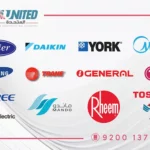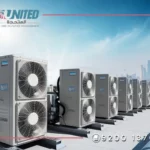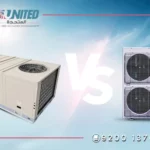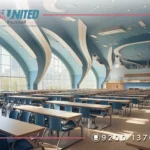The cooling load for air conditioning of hotels and residential towers is calculated according to the general standards indicated by the code (ASHRAE), noting that some international hotels such as Hilton, Sheraton have designed their own code for all systems used inside their hotels, provided that all the stipulated standards are adhered to
To mention but not limited to the air conditioning and heating system, all the required temperatures and humidity ratios for each room, corridor, gyms, swimming pools, dining halls and meeting rooms also determine the fresh air ratios for each individual.
Most hotels use all the space on the upper deck for outdoor sessions or open swimming pools, etc
And here comes the problem of saving space for external air conditioning units, so there are some architectural solutions such as a bounce work used to place the units on the rear exterior wall of the hotel in the case of hidden air conditioners
Or allocate a closed and surface-defined space in which all external units are assembled with a separation wall and an entrance door for easy maintenance operations
There are some solutions by choosing the appropriate air conditioning system, and recently the VRV or VRF air conditioning system has started (it consists of a number of indoor units of different types assembled on one copper network with one external unit), which reduces the space required for external units
Hotels are characterized by the number of many bedrooms, which requires a central control system” BMS " that allows monitoring all systems at the same time with easy control, fault detection and treatment, and the VRV or VRF air conditioning system facilitates this process as it is equipped for compatibility with the central control system
When distributing air outlets, the beds in the bedrooms should be taken into account so that the cold air is not directed directly at them, so when designing, the hotel's mattress scheme should be requested to achieve this
Some hotels have gyms, swimming pools, massage rooms, steam rooms, each of which has special specifications and requirements that must be observed and indicated by the universal code (ASHRAE) or the hotel code
When determining the location of the thermostat that controls the air conditioning devices, it is preferable to place it next to the light switches and it can be calibrated to an average temperature that suits everyone, and some of the options available are adjusted by the guest with the thermostat, such as (on and off, fan speed)
In some cases, they are assembled in one place (control room) or a centralized control system is made for all air conditioners, which allows workers the ability to adjust, control, operate and extinguish quickly, safely and simply
It is preferable to install air curtains at the entrances and exits to reduce the ingress of hot air inside the hotel, which can negatively affect the cooling efficiency
Some air fresheners can be installed in air conditioning units for corridors, restaurants and lounges, and an operating system is made at a time to ensure that a good smell of the place is maintained regularly and automatically
Periodic Maintenance of air conditioners and cleaning of their filters to reduce bacteria and unpleasant odors accumulated on them and to maintain cooling efficiency
Ventilation
As stated in the universal code (ASHRAE) on ventilation standards for hotels
The air renewal process comes at the head of these standards, as the air must be changed up to 10:6 times per hour (ACH Air change rate) in bathrooms
This is done in the framework of protecting personnel from infection and reducing bacteria, also to maintain a good smell of the place.
This is done in several ways, including natural methods (ventilation holes in walls, windows ...etc.) or mechanical methods (push and suction fans, moisture extraction devices ...etc.)






